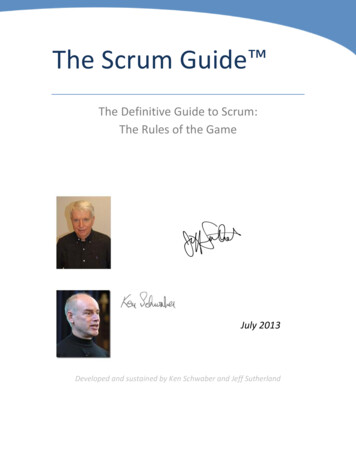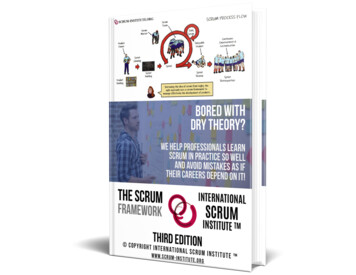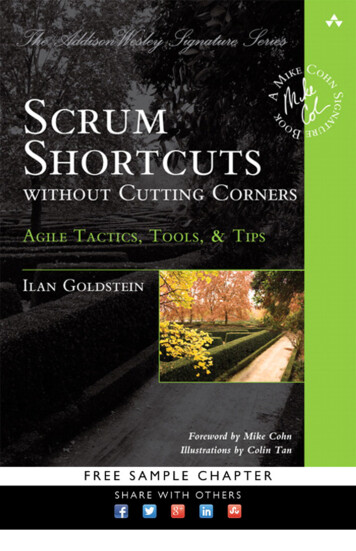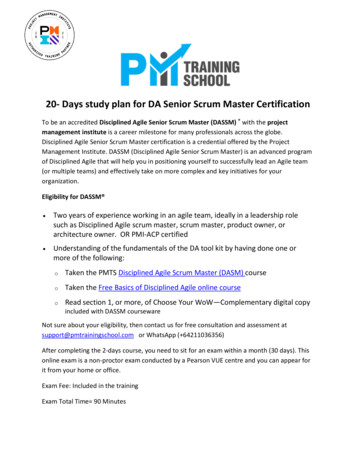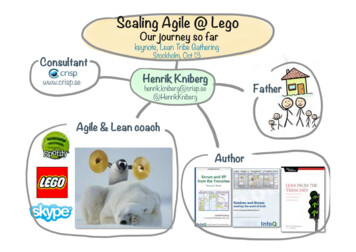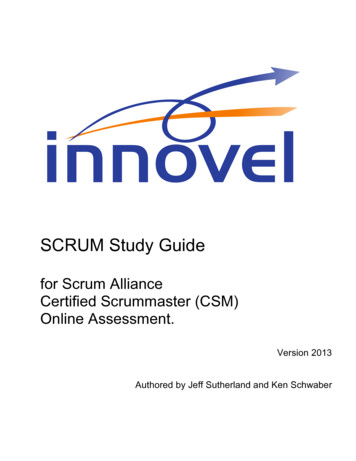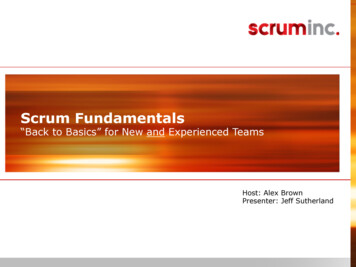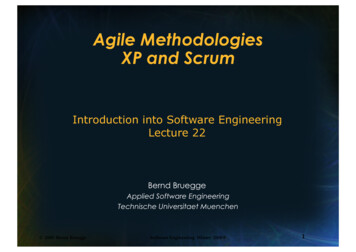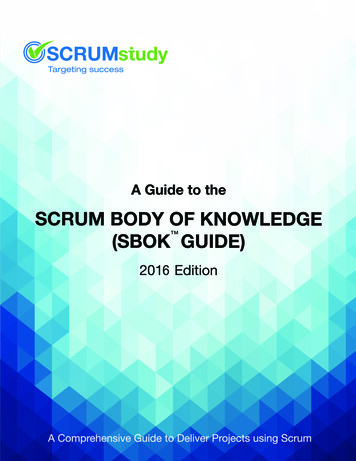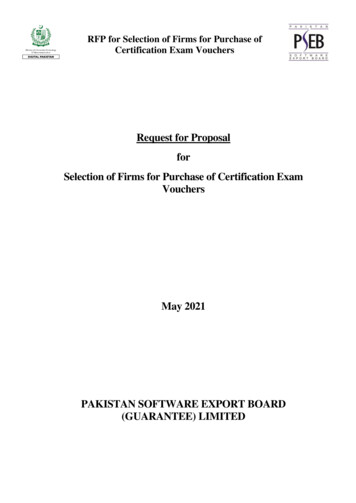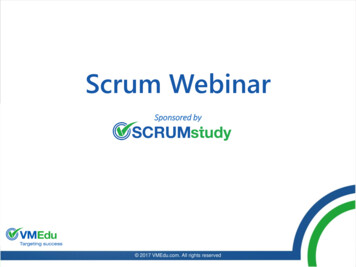
Transcription
Scrum WebinarSponsored by 2017 VMEdu.com. All rights reserved
Agenda1. Webinar Objectives2. Benefits to Participants joining this Webinar3. Conducting the webinar4. About VMEdu5. VMEdu Comprehensive Learning Programs:Scrum/Agile, PMP, Sales & Marketing, Six Sigma, Negotiation and more6. About SCRUMstudy Why Scrum Why SCRUMstudy Overview of the SBOK Guide Scaling Scrum for Large Projects and the Enterprise SCRUMstudy Certifications SCRUMstudy Certified Trainer, Certified Agile Coach Classroom Training Methodology Online Courses Mobile App7. Scrum/Agile Certification and Training8. Next Steps – Get Trained and Certified! 2017 VMEdu.com. All rights reserved2
Objectives Knowing more about VMEdu/SCRUMstudy – a leading global adult learningplatform Understanding Scrum, and the benefits of Scrum vis-a-vis traditional ProjectManagement Getting a high-level overview of the SCRUMstudy SBOKTM framework and howit helps in delivering successful projects. The SBOKTM framework is currentlythe most popular framework for Scrum/Agile in the industry. Learning about SCRUMstudy Certifications Learning how to become a SCRUMstudy Certified Trainer (SCTTM) orSCRUMstudy Certified Agile Coach (SCACTM). 2017 VMEdu.com. All rights reserved3
Benefits to Participants joining this webinarVOUCHER CODE: SCRUM50 (valid till Oct 20, 2017)Using this Voucher Code, all participants in this webinar will get access to Free 1 month VMEdu subscription (value 35 per month) with 1000 hours ofhigh quality videos, case studies and additional content about Scrum/Agile; andalso the best in class content about Digital Marketing, traditional ProjectManagement (PMP /PRINCE2 ), ITIL, CBAP, and multiple other courses. Link toenroll – http://www.vmedu.com/VCCP/Apply-VCCP. Subscription can beaccessed online or through mobile app. 50% discount on the physical copy of the SBOK Guide. (it will cost you 17.75including shipping charges). Buy now ee-buy-SBOK 50 discount for all SCRUMstudy Scrum certifications. Link to enroll:http://www.scrumstudy.com/Certification 50 discount (US/Canada only) on all SCRUMstudy physical and virtual classes.Link to enroll: http://www.scrumstudy.com/Classes Free Scrum Fundamentals Certification, 50 Free VMEdu RCUs / PMI PDUs 2017 VMEdu.com. All rights reserved4
Conducting the Webinar The webinar is being coordinated by 5 co-authors of the SBOK Guide: Gaynell Malone, Drew Nations,James Pruitt, Dr. Jose Nunez, and Nikhil Kumar.Gaynell MaloneDr. Jose NunezJames PruittNikhil Kumar 2017 VMEdu.com. All rights reservedDrew NationsArun Rahim5
Conducting the Webinar We have 3,000 persons participating in this webinar today, which makes it the biggestlive Scrum/Agile webinar globally. All participants in this webinar can ask questions to the VMEdu team by using the chatbutton provided in GotoWebinar. VMEdu team will try to answer all questions askedthrough the chat window. We will take 5 minutes break every hour. We hope you enjoy and learn from this webinar!*: Answers from VMEdu representatives in the chat window are the views of individuals representing VMEdu. Inc, and may notrepresent the official views of VMEdu Inc. 2017 VMEdu.com. All rights reserved6
Questions(please use the chat button provided in the Webinar) 2017 VMEdu.com. All rights reserved7
2017 VMEdu.com. All rights reserved8
About Us VMEdu is an accreditation body for Scrum & Agile, Sales & Marketing,Negotiation and Six Sigma. We provide comprehensive learning programs forPMP, PRINCE2, ITIL and several other courses. VMEdu also hosts 450 coursesfrom other Subject Matter Experts on our platform. Offer multi-modal learning through online or instructor-led classes. Includehigh-quality videos, podcasts, simulated exams, study guides, certifications,flashcards and more – all accessible via mobile app. Allow companies to conduct high-quality training classes using VMEdu's onlineand classroom course materials. World’s first Free Cloud-based Learning Management System(LMS) with freemobile app. Provide a single portal to access online courses, video lectures, certificationexams, and more.Note: Free 1 month VMEdu online subscription (including mobile app) is available to all participants in this webinar 2017 VMEdu.com. All rights reserved9
Our Investors VMEdu is funded by Sequoia Capital, a Californian venture capital firm. The firm is known for funding companies such as Apple, Aruba Networks,Google, WhatsApp, YouTube, PayPal, Cisco Systems, Oracle, Electronic Arts,Yahoo!, NVIDIA, Navigenics, Cotendo, Atari, Ameritox, Kayak, Meebo, Admob,Zappos, Green Dot and LinkedIn. The Wall Street Journal estimates that 19% of NASDAQ's value is accounted bySequoia funded firms.Note: Free 1 month VMEdu online subscription (including mobile app) is available to all participants in this webinar 2017 VMEdu.com. All rights reserved10
A leader in the professional training andcertification industry750,000 students7500 companies1450 training partners150 countries 2017 VMEdu.com. All rights reserved11
VMEduAccreditationBodySMstudySales &MarketingSCRUMstudyAgile and Scrum6sigmastudySix SigmaPMstudyPMP and CAPMITILContentProviderMyITstudyCOBITCBAPAs an Accreditation Body, VMEduworks with Subject Matter Expertsto create publications, courses andcertifications on Sales & Marketing,Scrum, Agile, and Six Sigma.As a Content Provider, VMEduoffers certification prep courseson PMP, CAPM, ITIL, COBIT, CBAP,PRINCE2 and MSPPRINCE2PROJstudyMSP 2017 VMEdu.com. All rights reserved12
Comprehensive Learning Programs 2017 VMEdu.com. All rights reserved13
Comprehensive Learning Programs (CLPs) Each CLP is provided by VMEdu brand websites such as PMstudy, SCRUMstudy,6sigmastudy, Ngstudy, and SMstudy. Each CLP is equivalent to 50 hours of learning through videos, case studies,classroom training modules, study guides, proctored certification exams, and more.Note: Free 1 month VMEdu online subscription (including mobile app) is available to all participants in this webinar 2017 VMEdu.com. All rights reserved14
Other 450 CoursesNote: Free 1 month VMEdu online subscription (including mobile app) is available to all participants in this webinar 2017 VMEdu.com. All rights reserved15
Questions(please use the chat button provided in the Webinar) 2017 VMEdu.com. All rights reserved16
2017 VMEdu.com. All rights reserved17
Why Scrum? Most popular Agile framework for projects. Adaptive, iterative, fast, flexible, and effective method designedto deliver significant value quickly and throughout a project. The Scrum framework, as defined in the SBOK Guide, isstructured in such a way that it supports product and servicedevelopment in all types of industries and in any type of project,irrespective of its complexity. Uses cross-functional, self-organized and empowered teamswho divide and execute their work in short, concentrated workcycles called Sprints. Focus on value-driven delivery helps Scrum Teams deliver resultsas early in the project as possible. 2017 VMEdu.com. All rights reserved18
Why Scrum? Adaptability Effective Deliverables Transparency Customer Centric Continuous Feedback High Trust Environment Continuous Improvement Collective Ownership Faster Problem Resolution Continuous Delivery of Values Efficient Development Process High Velocity Sustainable Pace Innovative Environment Early Delivery of High Value MotivationNote: Free 1 month VMEdu online subscription (including mobile app) is available to all participants in this webinar 2017 VMEdu.com. All rights reserved19
Growth of ScrumNote: Free 1 month VMEdu online subscription (including mobile app) is available to all participants in this webinar 2017 VMEdu.com. All rights reserved20
Scrum vs. Traditional ocumentationMinimal-only as requiredComprehensiveQuality assuranceCustomer centricProcess centricProcess gedUpfront PlanningLowHighPerspective toward changeAdaptabilitySustainabilityPrioritization of requirementsBased on business value andregularly updatedFixed in the project planManagement e, Servant LeadershipCommand and controlPerformance MeasurementBusiness valuePlan conformityReturns on InvestmentEarly/throughout project lifeEnd of project lifeNote: Free 1 month VMEdu online subscription (including mobile app) is available to all participants in this webinar 2017 VMEdu.com. All rights reserved21
Scrum blesRelease ScheduleDaily StandupMeetingSprint1-6 weeksProjectBusiness CaseProject VisionStatementProject Vision MeetingPrioritizedProduct BacklogSprintBacklogSprint Planning MeetingAcceptedDeliverablesSprint Review MeetingRetrospect Sprint MeetingNote: Free 1 month VMEdu online subscription (including mobile app) is available to all participants in this webinar 2017 VMEdu.com. All rights reserved22
Questions(please use the chat button provided in the Webinar) 2017 VMEdu.com. All rights reserved23
Why SCRUMstudy?Most Popular and Widely AcceptedBased on Scrum Body of Knowledge (SBOK Guide)Industry-wide AcceptanceCredible and Standard Testing EnvironmentMultiple Free Resources for Scrum & AgileCommunitySCRUMstudy certifies several thousand students each month – morethan any other accreditation body for Scrum and Agile.Details: https://www.scrumstudy.com/whyscrum/why-scrumstudy 2017 VMEdu.com. All rights reserved24
Why SCRUMstudy?Free "Scrum Fundamentals Certified" – SFC CourseStandardized Resources for SCRUMstudy TrainersOpen to Feedback from Scrum/Agile PractitionersActive Discussions to Share and LearnEstablished name in Scrum/Agile CertificationsSCRUMstudy LinkedIn Group was started just 2 years ago and now has 55,000 members.Details: https://www.scrumstudy.com/whyscrum/why-scrumstudy 2017 VMEdu.com. All rights reserved25
Overview of the SBOK GuideA Guide to the Scrum Body of Knowledge (SBOK Guide)provides guidelines for the successful implementation ofScrum—the most popular Agile product development andproject delivery method. Scrum, as defined in theSBOK Guide, is applicable to the following: Portfolios, programs, and/or projects in any industry Products, services, or any other results to be deliveredto stakeholders Projects of any size or complexityThe SBOK Guide is available forfree download atSCRUMstudy.comThe SBOK Guide can be used as a reference andknowledge guide by both experienced Scrum and otherproduct and service development practitioners, as well asby individuals with no prior experience or knowledge ofScrum or other project delivery methodology.Note: Free 1 month VMEdu online subscription (including mobile app) is available to all participants in this webinar 2017 VMEdu.com. All rights reserved26
The Scrum Framework is described by thePrinciples, Processes and BOK Guide FrameworkNote: Free 1 month VMEdu online subscription (including mobile app) is available to all participants in this webinar 2017 VMEdu.com. All rights reserved27
SBOK Guide: BUSINESS AN AND ESTIMATE10. IMPLEMENT11. REVIEW AND RETROSPECT12. RELEASE13. SCALING SCRUM FOR LARGE PROJECTS14. SCALING SCRUM FOR THE ENTERPRISENote: Free 1 month VMEdu online subscription (including mobile app) is available to all participants in this webinar 2017 VMEdu.com. All rights reserved28
Questions(please use the chat button provided in the Webinar) 2017 VMEdu.com. All rights reserved29
Introduction to ScrumFigure 1-1: Scrum Flow for one SprintAdditional Details: SBOK Pages 1-20; VMEdu online subscription (1 month free access to all participants in this webinar) 2017 VMEdu.com. All rights reserved30
Scrum PrinciplesScrumPrinciplesFigure 1-3: Scrum PrinciplesSBOK Page 9Additional Details: SBOK Pages 21-37; VMEdu online subscription (1 month free access to all participants in this webinar) 2017 VMEdu.com. All rights reserved31
Scrum ngeRiskAdditional Details: SBOK Pages 10-14; VMEdu online subscription (1 month free access to all participants in this webinar) 2017 VMEdu.com. All rights reserved32
Scrum Aspect: OrganizationFigure 3-1: Scrum Roles—Overview; SBOK – Page 42Additional Details: SBOK Pages 39-63; VMEdu online subscription (1 month free access to all participants in this webinar) 2017 VMEdu.com. All rights reserved33
Scrum Aspect: OrganizationFigure 3-4: Scrum Across the Organization for Projects, Programs, and Portfolios; SBOK – Page 53Additional Details: SBOK Pages 39-63; VMEdu online subscription (1 month free access to all participants in this webinar) 2017 VMEdu.com. All rights reserved34
Scrum Aspect: Business JustificationFigure 4-1: Delivering Value in Scrum vs. Traditional Projects; SBOK Page 67Additional Details: SBOK Pages 65-82; VMEdu online subscription (1 month free access to all participants in this webinar) 2017 VMEdu.com. All rights reserved35
Scrum Aspect: Business JustificationFigure 4-3: Business Justification and the Project Lifecycle; SBOK Page 71Additional Details: SBOK Pages 65-82; VMEdu online subscription (1 month free access to all participants in this webinar) 2017 VMEdu.com. All rights reserved36
Scrum Aspect: QualityFigure 5-3: PDCA Cycle in Scrum; SBOK Page 94Additional Details: SBOK Pages 83-95; VMEdu online subscription (1 month free access to all participants in this webinar) 2017 VMEdu.com. All rights reserved37
Scrum Aspect: ChangeFigure 6-2: Updating Prioritized Product Backlog with Approved Changes; SBOK Page 100Additional Details: SBOK Pages 97-115; VMEdu online subscription (1 month free access to all participants in this webinar) 2017 VMEdu.com. All rights reserved38
Scrum Aspect: Change?Figure 6-6: Integrating Change in Scrum; SBOK Page 107Additional Details: SBOK Pages 97-115; VMEdu online subscription (1 month free access to all participants in this webinar) 2017 VMEdu.com. All rights reserved39
Scrum Aspect: ChangeFigure 6-8: Incorporating Changes in Portfolio and Program; SBOK Page 113Additional Details: SBOK Pages 97-115; VMEdu online subscription (1 month free access to all participants in this webinar) 2017 VMEdu.com. All rights reserved40
Scrum Aspect: RiskFigure 7-4: Process for Risk Prioritization; SBOK Page 126Additional Details: SBOK Pages 117-133; VMEdu online subscription (1 month free access to all participants in this webinar) 2017 VMEdu.com. All rights reserved41
Scrum Aspect: RiskMinimizing Risks Through ScrumFlexibilityreducesbusinessenvironmentrelated riskRegularfeedbackreducesexpectationsrelated riskTeamownershipreducesestimation riskTransparencyreduces nondetection riskIterativedeliveryreducesinvestment riskAdditional Details: SBOK Pages 117-133; VMEdu online subscription (1 month free access to all participants in this webinar) 2017 VMEdu.com. All rights reserved42
Scrum Aspect: RiskFigure 7-6: Handling Risks in Portfolios and Programs; SBOK Page 131Additional Details: SBOK Pages 117-133; VMEdu online subscription (1 month free access to all participants in this webinar) 2017 VMEdu.com. All rights reserved43
Questions(please use the chat button provided in the Webinar) 2017 VMEdu.com. All rights reserved44
Scrum Phases & ProcessesInitiateCreate ProjectVisionPlan & EstimateImplementCreate User Stories Create DeliverablesIdentifyScrum Master &Stakeholder(s)Estimate UserStoriesConduct DailyStandupForm Scrum TeamCommit UserStoriesGroom PrioritizedProduct BacklogDevelop EpicsIdentify TasksCreate PrioritizedProduct BacklogEstimate TasksConduct ReleasePlanningCreate SprintBacklogReview &RetrospectReleaseDemonstrate andValidate SprintShip DeliverablesRetrospect SprintRetrospect ProjectAdditional Details: SBOK Pages 15-19; VMEdu online subscription (1 month free access to all participants in this webinar) 2017 VMEdu.com. All rights reserved45
Scrum Phase: InitiateFigure 8-2: Initiate Overview (Essentials); SBOK Page 138Additional Details: SBOK Pages 135-179; VMEdu online subscription (1 month free access to all participants in this webinar) 2017 VMEdu.com. All rights reserved46
Initiate Important Outputs – Scrum Team The Scrum Team, sometimes referred to as the Development Team, is a group or team ofpeople who are responsible for understanding the business requirements specified bythe Product Owner, estimating User Stories, and final creation of the projectDeliverables. Scrum Teams are cross-functional and self-organizing.Additional Details: SBOK Page 156; VMEdu online subscription (1 month free access to all participants in this webinar) 2017 VMEdu.com. All rights reserved47
Initiate Important Outputs – Epics Epics are written in the initial stages of the project when most User Stories are high-levelfunctionalities or product descriptions and requirements are broadly defined. They are large, unrefined User Stories in the Prioritized Product Backlog. Once these Epics come up in the Prioritized Product Backlog for completion in anupcoming Sprint, they are then broken down into smaller, more granular User Stories. These smaller User Stories are generally simple, short, and easy to implementfunctionalities or blocks of tasks to be completed in a Sprint.Additional Details: SBOK Page 164; VMEdu online subscription (1 month free access to all participants in this webinar) 2017 VMEdu.com. All rights reserved48
Initiate Important Outputs – Personas Personas are highly detailed fictional characters, representative of the majority of usersand of other stakeholders who may not directly use the end product. Personas are created to identify the needs of the target user base. Creating specific Personas can help the team better understand users and theirrequirements and goals. Example:Vanessa is a 39 year old resident of San Francisco. She is pursuing her passion fortraveling after having a highly successful career as an attorney. She likes to have optionswhile picking air travel and accommodation services so that she can choose the best andthe most affordable. She gets frustrated with slow and cluttered websites.Additional Details: SBOK Page 164; VMEdu online subscription (1 month free access to all participants in this webinar) 2017 VMEdu.com. All rights reserved49
Initiate Important Outputs – PrioritisedProduct Backlog The Product Owner develops a Prioritized Product Backlog which contains a prioritizedlist of business and project requirements written in the form of Epic(s), which are highlevel User Stories. The Prioritized Product Backlog is based on three primary factors: value, risk oruncertainty, and dependencies.Additional Details: SBOK Page 171; VMEdu online subscription (1 month free access to all participants in this webinar) 2017 VMEdu.com. All rights reserved50
Initiate Important Outputs – Done criteria Done Criteria are a set of rules that are applicable to all User Stories. A clear definition of Done is critical, because it removes ambiguity fromrequirements and helps the team adhere to mandatory quality norms. General Done Criteria could include any of the following: Reviewed by other team members Completed unit testing of the User Story Completion of quality assurance tests Completion of all documentation related to the User Story All issues are fixed Successful demonstration to stakeholders and/or business representativesAdditional Details: SBOK Page 172; VMEdu online subscription (1 month free access to all participants in this webinar) 2017 VMEdu.com. All rights reserved51
Initiate Important Outputs – Length ofSprint Based on the various inputs including business requirements and ReleasePlanning Schedule, the Product Owner and the Scrum Team decide on theLength of Sprint for the project. Once determined, the Length of Sprint often remains the same throughout theproject. However, the Length of Sprint may be changed if and as the Product Ownerand the Scrum Team deem appropriate. A Sprint could be Time-boxed from 1 to 6 weeks. However, to get maximumbenefits from a Scrum project, it is recommended to keep the maximum lengthof Sprint Time-boxed to 4 weeks.Additional Details: SBOK Page 177; VMEdu online subscription (1 month free access to all participants in this webinar) 2017 VMEdu.com. All rights reserved52
Questions(please use the chat button provided in the Webinar) 2017 VMEdu.com. All rights reserved53
Scrum Phase: Plan & EstimateFigure 9-2: Plan and Estimate Overview (Essentials); SBOK Page 184Additional Details: SBOK Pages 181-211; VMEdu online subscription (1 month free access to all participants in this webinar) 2017 VMEdu.com. All rights reserved54
Plan & Estimate Phase - Important OutputsUser Stories User Stories adhere to a specific, predefined structure and are a simplistic wayof documenting the requirements and desired end-user functionality. A User Story tells you three things about the requirement: Who, What, andWhy. The requirements expressed in User Stories are short, simple, and easy-tounderstand statements. User Story Format:As a role/persona , I should be able to requirement so that benefit . User Story Example: As a Database Administrator, I should be able to revert a selected numberof database updates so that the desired version of the database is restored. As a Web developer, I should be able to track user data through theirunique login, so that I can enable customization of product and serviceofferings to the visitors. As a customer, I should be able to log in as a guest, so that I can check theofferings without registration when constrained by time.Additional Details: SBOK Page 189; VMEdu online subscription (1 month free access to all participants in this webinar) 2017 VMEdu.com. All rights reserved55
Plan & Estimate Phase - Important OutputsUser Story Acceptance Criteria Every User Story has an associated Acceptance Criteria. User Stories are subjective, so the Acceptance Criteria provide the objectivity requiredfor the User Story to be considered as Done or not Done during the Sprint Review. Acceptance Criteria provide clarity to the team on what is expected of a User Story,remove ambiguity from requirements, and help in aligning expectations. Example: Persona: Janine is a married 36 year old working professional with a family of threechildren. She is a busy, successful woman who balances her professional and personallife. She is comfortable with technology and is an early adopter of innovative servicesand products. She is always connected to the internet through multiple devices andregularly shops on e-commerce portals. User Story: “As an online grocery shopper Janine, I should be able to save and viewmy draft order from any of my devices so that I can complete the order process at myconvenience.” Acceptance Criteria: Every in-progress order must be saved every 5 seconds to the logged in useraccount as a draft order New draft orders must show up as notifications on any devices the user logs inAdditional Details: SBOK Page 190; VMEdu online subscription (1 month free access to all participants in this webinar) 2017 VMEdu.com. All rights reserved56
Plan & Estimate Phase - Important ToolEstimation Methods In the Plan & Estimate phase, Estimation Methods are used to estimate User Storiesand Tasks. Some important tools used for Estimation include: Wideband Delphi: Wideband Delphi is a group-based estimation technique fordetermining how much work is involved and how long it will take to complete. Planning Poker: Planning Poker, also called Estimation Poker, is a derivative ofthe Wideband Delphi technique. This is an estimation technique which usesconsensus to estimate relative sizes of User Stories or the effort required tocreate them. Fist of Five: Fist of Five is a simple and fast mechanism that can be used as anestimation practice, as well as a general group consensus building technique.After initial discussion on a given item for estimation, the Scrum Team membersare each asked to vote on a scale of 1 to 5 using their fingers. Affinity Estimation: Affinity Estimation is a technique used to quickly estimate alarge number of User Stories. Using sticky notes or index cards and tape, theteam places User Stories on a wall or other surface, in order from small to large.Additional Details: SBOK Page 193; VMEdu online subscription (1 month free access to all participants in this webinar) 2017 VMEdu.com. All rights reserved57
Plan & Estimate Phase - Important OutputsEffort Estimated Task List The Effort Estimated Task List is a list of tasks associated with the CommittedUser Stories included in a Sprint. Typically the accuracy of estimates varies with team skills. Estimated effort isexpressed in terms of the Estimation Criteria agreed on by the team.Additional Details: SBOK Page 206; VMEdu online subscription (1 month free access to all participants in this webinar) 2017 VMEdu.com. All rights reserved58
Plan & Estimate Phase - Important OutputsSprint Backlog The list of the tasks to be executed by the Scrum Team in the upcoming Sprint is calledthe Sprint Backlog. Each Scrum Team member also uses Effort Estimated Task List to select the tasks theyplan to work on in the Sprint, based on their skills and experience. The list of the tasks to be executed by the Scrum Team in the upcoming Sprint is calledthe Sprint Backlog.Additional Details: SBOK Page 209; VMEdu online subscription (1 month free access to all participants in this webinar) 2017 VMEdu.com. All rights reserved59
Plan & Estimate Phase - Important OutputsSprint Burndown ChartStory Points The Sprint Burndown Chart is a graph that depicts the amount of work remaining in theongoing Sprint. The initial Sprint Burndown Chart is accompanied by a plannedburndown. The Sprint Burndown Chart should be updated at the end of each day as work iscompleted.SprintAdditional Details: SBOK Page 210; VMEdu online subscription (1 month free access to all participants in this webinar) 2017 VMEdu.com. All rights reserved60
Questions(please use the chat button provided in the Webinar) 2017 VMEdu.com. All rights reserved61
Scrum Phase: ImplementFigure 10-2: Implement Overview (Essentials); Page 216Additional Details: SBOK Page 213-233; VMEdu online subscription (1 month free access to all participants in this webinar) 2017 VMEdu.com. All rights reserved62
Implement Phase - Important OutputsScrumboard Scrum's transparency comes from openly viewable information tools like theScrumboard, which shows the progress of the team. The team uses a Scrumboard to planand track progress during each Sprint. The Scrumboard contains four columns to indicatethe progress of the estimated tasks for the SprintAdditional Details: SBOK Page 221; VMEdu online subscription (1 month free access to all participants in this webinar) 2017 VMEdu.com. All rights reserved63
Implement Phase - Important OutputsImpediment Log An impediment is any hindrance or hurdle that reduces the productivity of theScrum Team. Impediments must be identified, resolved and removed if theteam is to continue working effectively. Impediments can be internal to the team, such as inefficient workflow or lackof communication; or they can be external, such as software license issues,legal or government compliance requirements etc. Impediments should be formally recorded by the Scrum Master in anImpediment Log, and can be discussed during Daily Standup Meetings andSprint Review Meetings as appropriate.Additional Details: SBOK Page 221; VMEdu online subscription (1 month free access to all participants in this webinar) 2017 VMEdu.com. All rights reserved64
Implement Phase - Important ToolDaily Standup Meeting The Daily Standup Meeting is a short daily meeting, Time-boxed to 15 minutes. Team members assemble to report their progress in the Sprint and plan the day’sactivities. The meeting duration is very short and all members of the Scrum Team are expected toattend.Additional Details: SBOK Page 225; VMEdu online subscription (1 month free access to all participants in this webinar) 2017 VMEdu.com. All rights reserved65
Implement Phase - Important ToolThree Daily Questions In the Daily Standup Meeting, facilitated by the Scrum Master, each ScrumTeam member provides information in the form of answers to three specificquestions: What have I done since the last meeting? What do I plan to do before the next meeting? What impediments or obstacles (if any) am I currently facing? By focusing on these three questions, the entire team can have a clearunderstanding of the work status. Occasionally, other items may be discussed,but this is kept to a minimum in light of the Time-boxed nature of the meeting.Additional Details: SBOK Page 225; VMEdu online subscription (1 month free access to all participants in this webinar) 2017 VMEdu.com. All rights reserved66
Questions(please use the chat button provided in the Webinar) 2017 VMEdu.com. All rights reserved67
Scrum Phase: Review & RetrospectFigure 11-2: Review and Retrospect Overview; SBOK Page 239Additional Details: SBOK Pages 235-247; VMEdu online subscription (1 month free access to all participants in this webinar) 2017 VMEdu.com. All rights reserved68
Review & Retrospect Phase - Important ToolSprint Review Meeting The Scrum Core Team members and relevant Stakeholder(s) participate in Sprint ReviewMeetings to accept the deliverables which meet the User Story Acceptance Criteria andreject unaccep
A Guide to the Scrum Body of Knowledge (SBOK Guide) provides guidelines for the successful implementation of Scrum—the most popular Agile product development and project delivery method. Scrum, as defined in the SBOK Guide, is applicable to the followi
